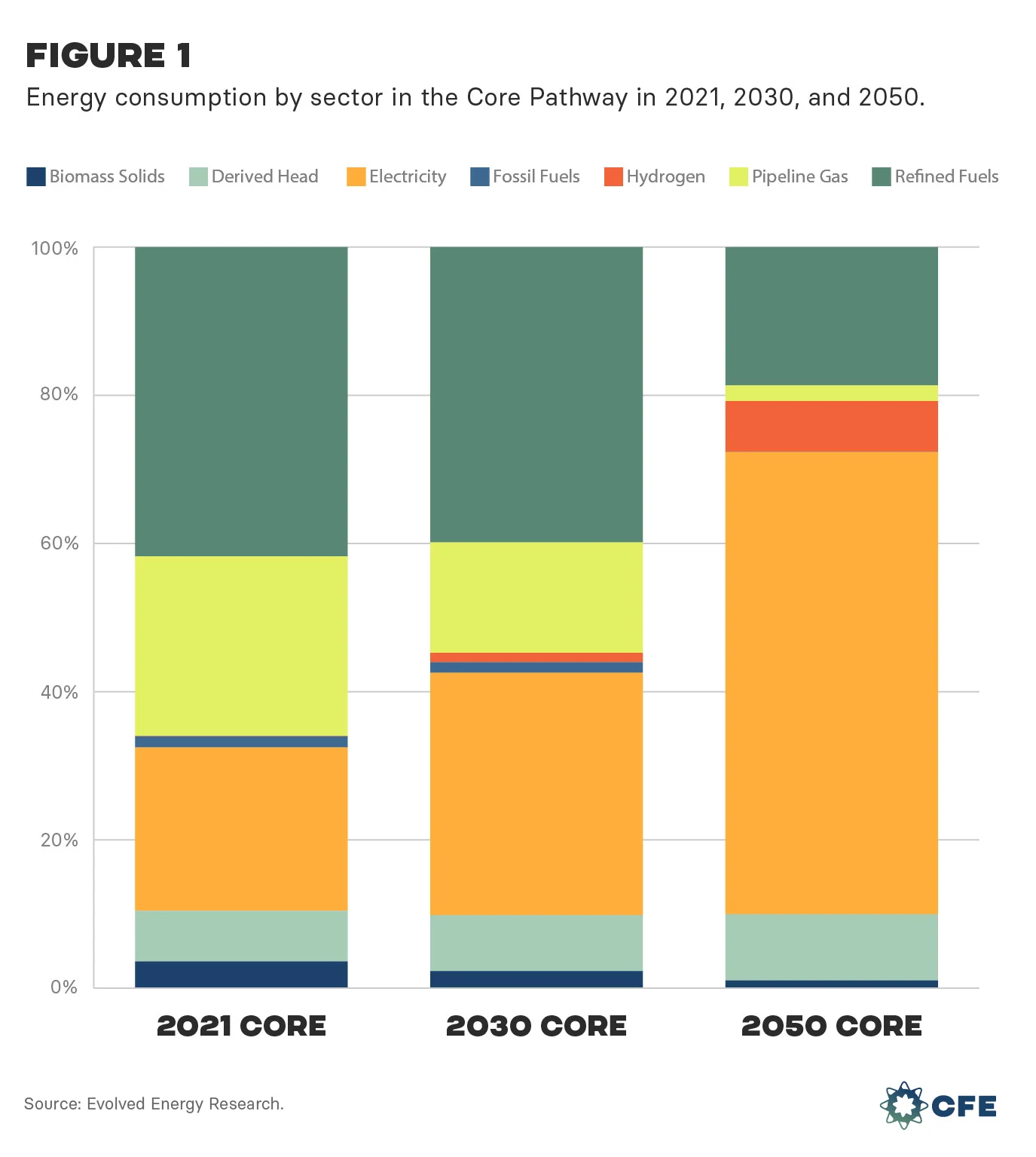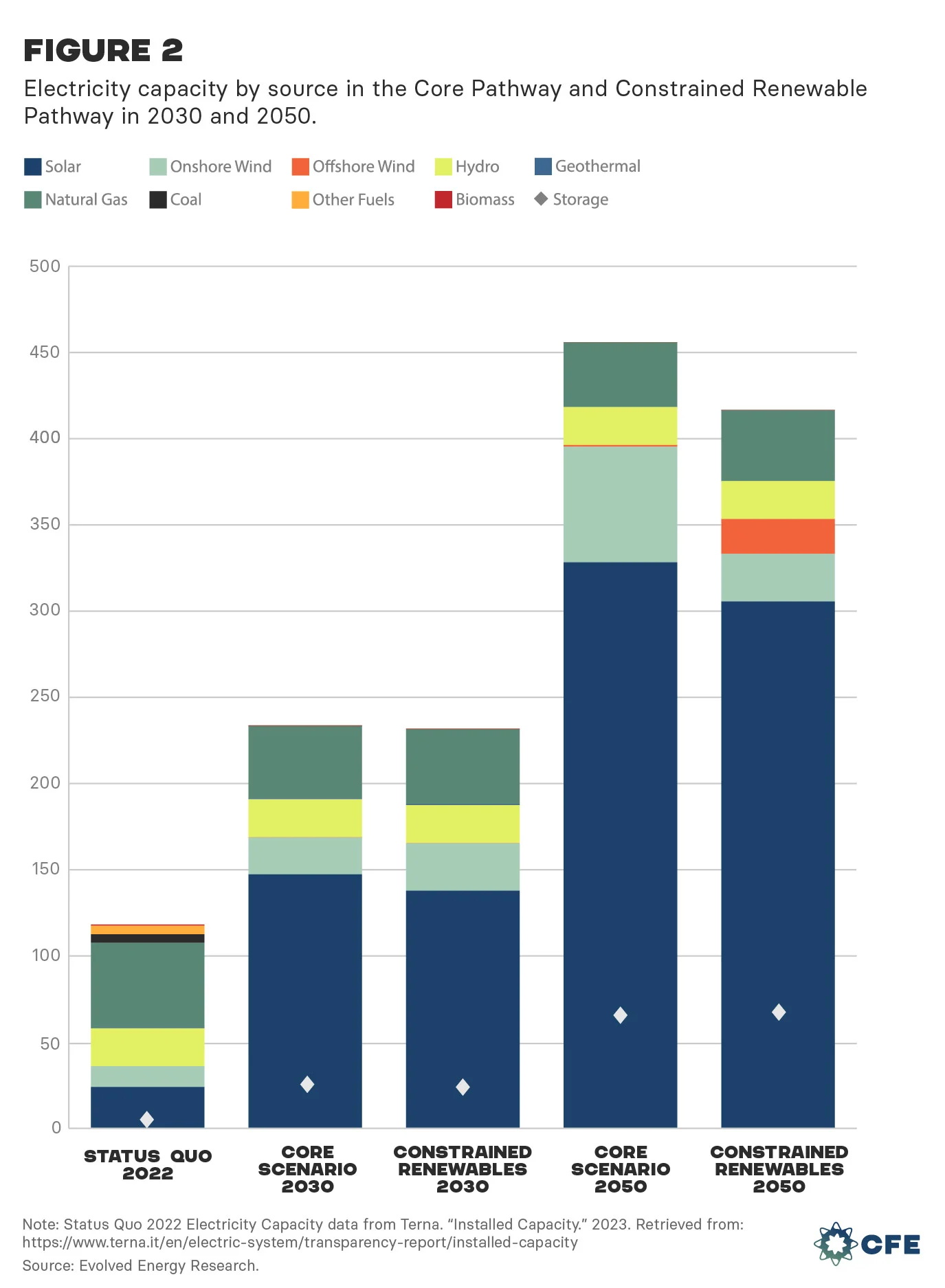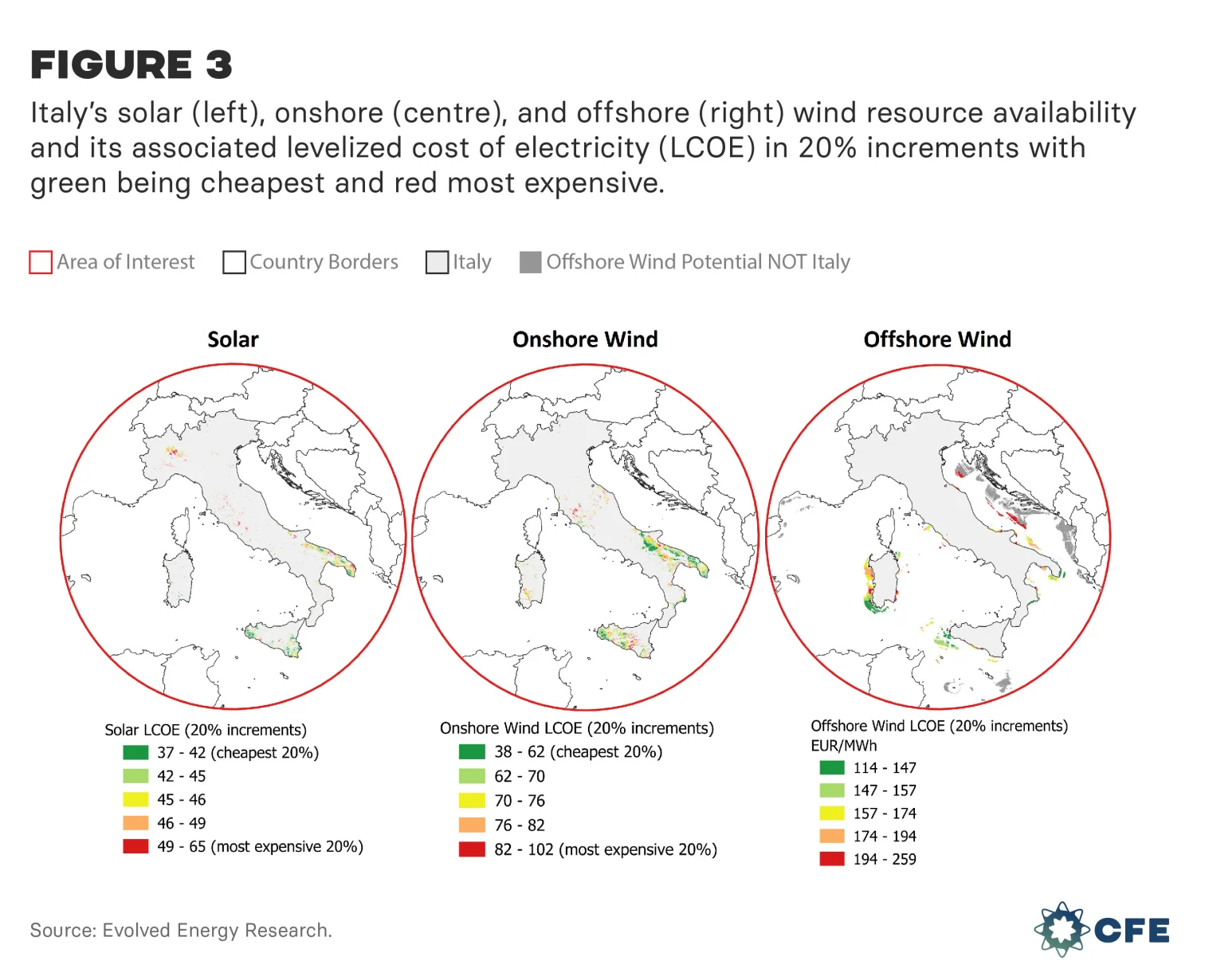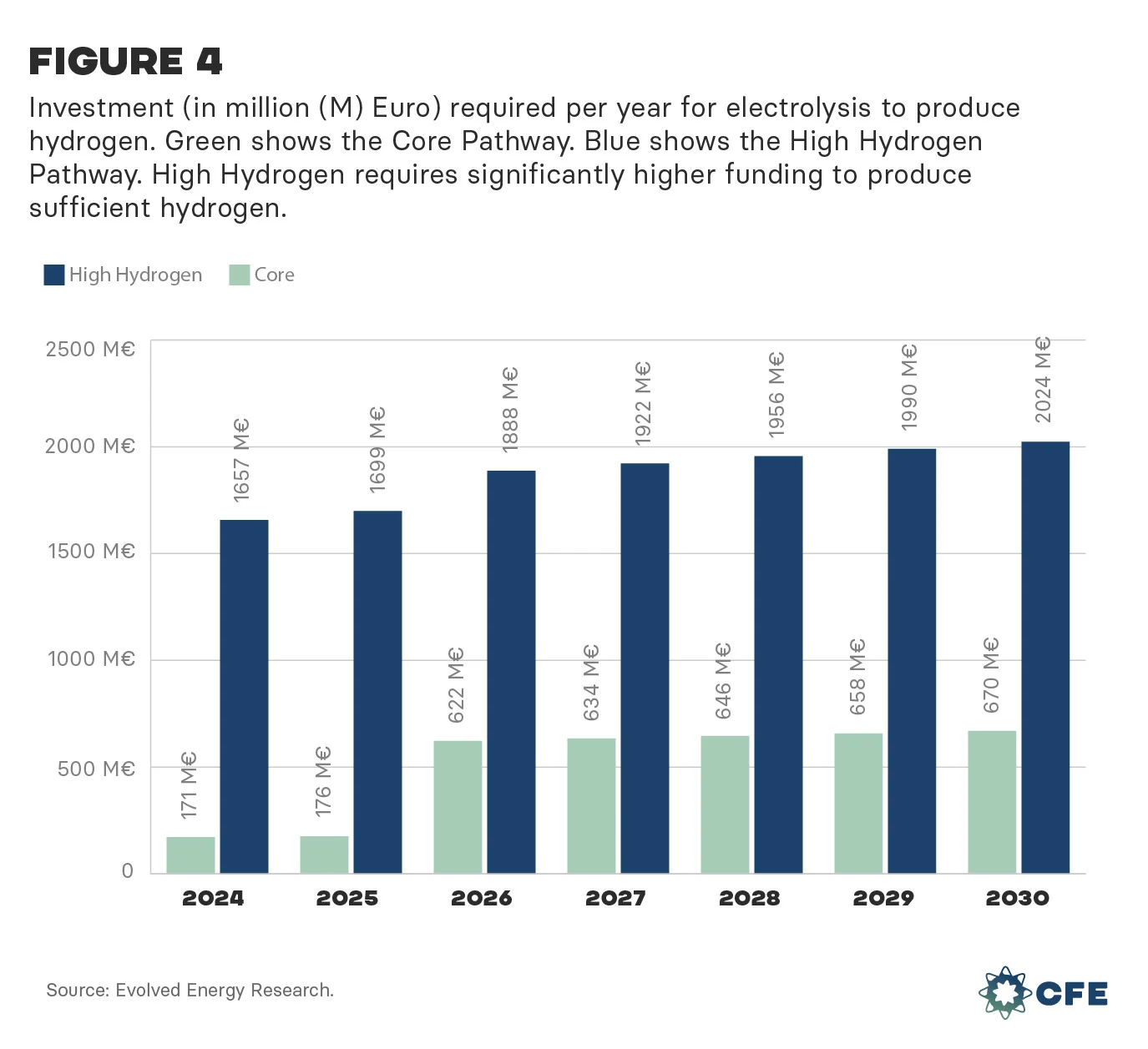Takeaways
-
Powering Up the Power Sector: Italy requires massive investment in and deployment of renewable electricity capacity to move away from fossil fuel dependence.
-
Building Public Support for Decarbonisation: Italy should involve a range of different actors, agencies, and community representatives in the decision-making process to ensure public acceptance.
-
Bridging the Geographical Divide: Italy requires investment into domestic and cross-border T&D and electricity storage infrastructure to ensure grid stability and security.
-
Embracing Technology Inclusivity: Italy must expand its hydrogen supply chain and explore clean energy technology to ease transition for hard-to-electrify sectors. Italy will benefit from a diversified energy system that boosts resilience, security, independence from fossil fuels, and strategic autonomy.
Introduction
Within the next year, Italy will need to update its National Energy and Climate Plan (NECP) and long-term energy strategy to reflect the latest EU targets. Not only does Italy need to reach at least 55% emissions reduction by 2030, it also needs to meet specific targets established in the Fit-for-55 package and REPowerEU for deploying clean energy, reducing energy demand, and diversifying energy supplies.
Italy’s last NECP, published in December 2019, set a preliminary goal of a 33% reduction compared to 2005 GHG emissions by 2030.1 While it is on track to meet this target, Italy will need to reshape its energy systems to keep pace with the more ambitious reductions linked to the EU’s binding targets.
The country’s energy mix still relies heavily on fossil fuels, comprising 83.4% of the energy supply and powering 63.5% of the country’s electricity.2 Much of that fuel comes from Russia, which only increases the urgency to decarbonise to shake Italy free of its dependency on unreliable partners that yield energy as a geopolitical weapon. There is no one-size-fits-all strategy to achieve these ambitious emissions reduction and energy security targets. Italy, as with other member states, must chart a course to net zero that suits its needs and plays to national strengths.
Despite two strong motivators for decarbonisation—climate mitigation and energy security—Italy still faces significant roadblocks in its path to emissions abatement. The country’s bureaucratic processes and regulations, coupled with the challenges of maintaining popular support for emissions reductions, will challenge the country’s efforts to meet its goals. We have seen this playout over the past decade as renewable energy deployment has slowed significantly compared to years prior. The country also faces a mismatch between the locus of demand (northern Italy) and the locus of production, areas with the greatest potential for renewable generation (southern Italy).
In this memo, we confront these challenges head on and outline the changes needed to allow Italy to meet its emissions abatement goals, in the face of the country’s unique sociopolitical challenges. Our analysis highlights four key areas of improvement to help Italy meet its new, more ambitious climate targets:
- Powering Up the Power Sector
- Building Public Support for Decarbonisation
- Bridging the Geographical Divide
- Embracing Technology Inclusivity
Methodology
This memo is part of a broader study from Carbon-Free Europe (CFE) that models 12 potential pathways (5 scenarios and 7 sensitivities) for the EU and UK to achieve net zero emissions by 2050. This report includes an assessment of what it will take for Italy’s energy system to reach carbon-neutrality across three of the 12 potential pathways:
-
Core Pathway: This path allows countries to use all available clean energy technologies, in line with their national policies, and assumes high levels of energy efficiency and electrification. It is the most feasible, cost-effective path to net zero.
-
Constrained Renewables Pathway: This pathway considers less available land for solar and onshore power than the Core Pathway because of siting, permitting, supply chain, or social constraints.
-
High Hydrogen Pathway: This path assumes delayed efforts to electrify end-uses like vehicles and industrial processes as compared to the Core Pathway, increasing the demand for zero-carbon fuels to replace liquid fossil fuels.
To learn more about the other pathways and our full 2023 analysis, please click here.
Powering Up the Power Sector
Our analysis identifies a gap between Italy’s current electricity generation and capacity, and what is needed to achieve net zero emissions by 2050. CFE’s model reveals that the most feasible path to net zero (known in our analysis as the ‘Core Pathway’) will require a fourfold increase in electricity capacity, bringing Italy’s total electricity capacity from 118 gigawatts (GW) today to 234 GW in 2030 and 456 GW in 2050. While overall primary energy consumption will decrease with energy efficiency improvements from 145 Mtoe in 20223 to 76 Mtoe by 2050 (Core Pathway), the increase in electricity demand is inevitable as Italy electrifies economic sectors such as industry, residential, and transport.

In 2022, fossil fuels made up 50% of Italy’s electricity capacity.4 To meet its climate goals, the country must reduce that figure to 18% by 2030 and 8% by 2050. This small amount of remaining fossil fuel capacity is maintained for reliability in extreme events. Italy can then deploy carbon capture and carbon sequestration technologies to counterbalance the remaining 8% fossil fuel-based electricity generation, or even run gas turbines with low carbon fuels like ammonia instead of fossil fuels.
These changes strike a delicate balance: Italy must dramatically increase electricity production, while, simultaneously, transforming how it generates electricity. Renewable proliferation is happening in Italy, but it will need to move faster than ever before to meet the country’s needs and climate goals. The country’s renewable energy supply needs to increase from the 59 GW capacity calculated in 2022 to 419 GW by 2050, according to our analysis.
In practice, which increase requires at least 18,300 additional onshore wind turbines, with an average power of 3MV and an additional 3,630 Photovoltaic (PV) farms with an 84 MW capacity. That means the country will need to build almost 4000 PV farms that match the output of the country’s second largest PV farm, the Montalto di Castro PV power station, which covers 166 hectares and has more than 275,000 operational solar modules.5 It is no exaggeration to say that increasing renewable deployment to this scale will be a massive undertaking. Our analysis shows it will also require significant investment: constructing both solar and onshore wind is estimated to cost at least 282 and 93 billion Euro by 2050. To meet its goals, Italy will need to leverage public sector investment and regulatory signals to crowd in significant private sector investment.
Building Public Support for Decarbonisation
Public support for clean energy technology plays a critical role in deployment, in particular for renewables like solar and on- and offshore wind. Without adequate support from individuals and civil society, projects can slow significantly or halt entirely, posing a major hurdle to the clean energy transition.
Building an additional 305 GW of solar and 55 GW of onshore wind requires large areas of land and roofs, perhaps prompting a “NIMBY” mentality (not in my backyard) that could prove difficult to overcome as the Italian government works to deploy additional energy resources.
Should the Italian government fail to build adequate public support for new projects on land, as indicated in our Constrained Renewables Pathway, Italy will need to rely on additional offshore wind development (20 GW) to replace solar and onshore wind and meet its climate goals. That shift in electricity capacity, from more onshore capacity in the Core Pathway to more offshore capacity in the Constrained Renewables Pathway, will make the energy transition much more expensive, requiring an additional 12 billion Euro investment by 2050.
To avoid this costly and politically untenable situation, the Italian government must involve a range of different actors, agencies, and community representatives in the decision-making process. Italy should work to build consensus that increased clean energy proliferation is good for Italy’s economy, community, and future wellbeing. Ensuring public acceptance and involvement is pivotal to reaching the 2050 targets. The Italian government should also consider more energy dense resources like nuclear energy which, despite their high upfront cost, have smaller land footprints while providing more and firm zero-carbon electricity capacity.
Bridging the Geographical Divide
Italy has historically been an electricity import country. In 2022, Italy required 47.4 TWh of imports compared to 4.4 TWh of exports.6 Demand for electricity is highest in Northern Italy with 58% of electricity consumption in 2022.7 Italy’s North holds the bulk of the country's industrial activity, but solar and onshore wind capacity, which is modelled to provide 96% of the country’s electricity generation under the Core and High Hydrogen pathway, are concentrated in the south-eastern region and in Sicily and Sardegna. This mismatch makes it hard for the north of Italy to obtain the energy it needs and makes it harder to obtain public support in regions where ambitious renewable deployment efforts are instead required.
The practical challenge inherit in this geographical mismatch will require substantial investment in domestic and cross-country transmission and distribution (T&D) infrastructure. Terna announced a 21 billion Euro domestic T&D investment by 2033.8 In addition, our Core pathway models cross-country transmission investments of 2 billion Euro by 2030, like Terna’s development plan, and 4 billion Euro by 2050 to expand grid capacity to Tunisia, Greece, Austria, France, Slovenia, and Switzerland. In addition, due to the power intermittency and solar dependence (solar share will need to be 79% of electricity composition by 2050 according to our Core Pathway) Italy will have to invest at least 78 billion Euro into cost-effective electricity storage solutions with a capacity of at least 64 GW, dwarfing the current 3 GW of storage capacity.
Embracing Technology Inclusivity
Renewable technologies are the key power resource to reduce greenhouse gas emissions, and they are essential to meeting net zero targets. Reaching carbon neutrality and ensuring stability in the energy system with a purely renewable approach is significantly harder than an approach that uses a broader diversity of clean energy technologies. Italy is already relying on significant amounts of electricity imports. Dependency on purely intermittent electricity capacity may create bottlenecks at cross-country transmission. Deploying a broad array of energy sources helps ensure the energy system is strong, resilient to change, and secure. A renewables-only approach is more land-intensive and less resilient than an energy sector that deploys a broader range of clean energy technologies including nuclear, clean hydrogen, and geothermal.
Nuclear energy is independent of weather resources. Advanced small modular reactors could be built in Italy’s North, where solar and onshore wind resources are lacking. Nuclear thus reduces transmission and distribution costs, uses less land,9 provides highly efficient, concentrated, and firm electricity when intermittent power systems do not operate, and high temperature operations can be used for district heating and hydrogen production. Additionally, hard to electrify industrial processes that rely on high temperature heat could use nuclear power stations to meet their energy needs.
Clean hydrogen produced by nuclear-based high temperature electrolysis can provide fuel for hard-to-electrify transportation subsectors such as heavy-duty trucks or industrial work. Our Core Pathway suggests that by 2050 Italy could produce 40-50% more green hydrogen than it requires domestically, making Italy the third largest green hydrogen producer in the EU, enabling export, and providing a stable energy source for critical manufacturing.
Our High Hydrogen pathway, however, indicates that, should the country delay electrification, Italy will be required to produce even more hydrogen than illustrated in the Core Pathway in order to meet its domestic energy needs and provide essential hydrogen export to other European economies that have limited hydrogen production abilities. In this pathway, without nuclear power, Italy would require 38 GW of additional renewable electricity capacity to produce hydrogen for both domestic and trade needs to lower greenhouse gas emissions.
The current insufficient funding via the National Hydrogen Strategy and the 450 million Euro State Aid by the EU Commission10 is but barely a jumpstart compared to the costs our pathways predict. According to our Core and High Hydrogen pathways, the government needs to invest significantly higher funds to develop and shift its focus toward hydrogen as a clean energy technology, especially if electrification is delayed (High Hydrogen Pathway).
Incorporating a strong hydrogen supply chain using both renewable and nuclear power is an essential move that would ease the transition to net zero for hard-to-electrify sectors, while boosting the resilience of Italy’s energy system independent of delays. This clean technology inclusive approach can make Italy a clean energy leader that ensures European energy security, independence from Russian fossil fuels, and strengthens Italy’s strategic autonomy and role in Europe’s net zero ambitions.
Conclusion
Italy's decarbonization challenge is attainable. It requires a comprehensive shift in the power sector, led by a transition from fossil fuels to renewables, coupled with robust public support. Bridging geographical disparities will be essential and considering a clean technology-inclusive approach can ease Italy’s journey toward a decarbonised economy. This transformative path aligns with climate goals and provides greater energy security, economic resilience, and reduced dependence on intermittent electricity sources. Italy has an opportunity to lead by example in Europe's clean energy transition and ensure a sustainable and secure energy future.




